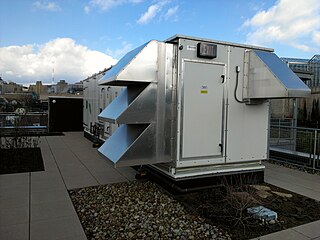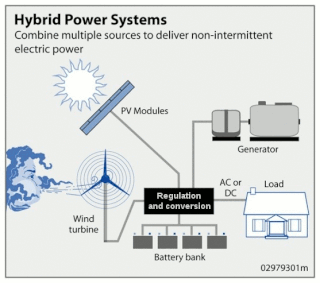
In electricity generation, a generator is a device that converts motion-based power or fuel-based power into electric power for use in an external circuit. Sources of mechanical energy include steam turbines, gas turbines, water turbines, internal combustion engines, wind turbines and even hand cranks. The first electromagnetic generator, the Faraday disk, was invented in 1831 by British scientist Michael Faraday. Generators provide nearly all the power for electrical grids.

Thermoelectric materials show the thermoelectric effect in a strong or convenient form.
Energy harvesting (EH) – also known as power harvesting,energy scavenging, or ambient power – is the process by which energy is derived from external sources, then stored for use by small, wireless autonomous devices, like those used in wearable electronics, condition monitoring, and wireless sensor networks.
An atomic battery, nuclear battery, radioisotope battery or radioisotope generator is a device which uses energy from the decay of a radioactive isotope to generate electricity. Like nuclear reactors, they generate electricity from nuclear energy, but differ in that they do not use a chain reaction. Although commonly called batteries, they are technically not electrochemical and cannot be charged or recharged. They are very costly, but have an extremely long life and high energy density, and so they are typically used as power sources for equipment that must operate unattended for long periods of time, such as spacecraft, pacemakers, underwater systems and automated scientific stations in remote parts of the world.

Off-the-grid or off-grid is a characteristic of buildings and a lifestyle designed in an independent manner without reliance on one or more public utilities. The term "off-the-grid" traditionally refers to not being connected to the electrical grid, but can also include other utilities like water, gas, and sewer systems, and can scale from residential homes to small communities. Off-the-grid living allows for buildings and people to be self-sufficient, which is advantageous in isolated locations where normal utilities cannot reach and is attractive to those who want to reduce environmental impact and cost of living. Generally, an off-grid building must be able to supply energy and potable water for itself, as well as manage food, waste and wastewater.
Thermophotovoltaic (TPV) energy conversion is a direct conversion process from heat to electricity via photons. A basic thermophotovoltaic system consists of a hot object emitting thermal radiation and a photovoltaic cell similar to a solar cell but tuned to the spectrum being admitted from the hot object.

Energy recovery includes any technique or method of minimizing the input of energy to an overall system by the exchange of energy from one sub-system of the overall system with another. The energy can be in any form in either subsystem, but most energy recovery systems exchange thermal energy in either sensible or latent form.
Micropower describes the use of very small electric generators and prime movers or devices to convert heat or motion to electricity, for use close to the generator. The generator is typically integrated with microelectronic devices and produces "several watts of power or less." These devices offer the promise of a power source for portable electronic devices which is lighter weight and has a longer operating time than batteries.

A load bank is a piece of electrical test equipment used to simulate an electrical load, to test an electric power source without connecting it to its normal operating load. During testing, adjustment, calibration, or verification procedures, a load bank is connected to the output of a power source, such as an electric generator, battery, servoamplifier or photovoltaic system, in place of its usual load. The load bank presents the source with electrical characteristics similar to its standard operating load, while dissipating the power output that would normally be consumed by it. The power is usually converted to heat by a heavy duty resistor or bank of resistive heating elements in the device, and the heat removed by a forced air or water cooling system. The device usually also includes instruments for metering, load control, and overload protection. Load banks can either be permanently installed at a facility to be connected to a power source when needed, or portable versions can be used for testing power sources such as standby generators and batteries. They are necessary adjuncts to replicate, prove, and verify the real-life demands on critical power systems. They are also used during operation of intermittent renewable power sources such as wind turbines to shed excess power that the electric power grid cannot absorb.

A stand-alone power system, also known as remote area power supply (RAPS), is an off-the-grid electricity system for locations that are not fitted with an electricity distribution system. Typical SAPS include one or more methods of electricity generation, energy storage, and regulation.

A thermoelectric generator (TEG), also called a Seebeck generator, is a solid state device that converts heat directly into electrical energy through a phenomenon called the Seebeck effect. Thermoelectric generators function like heat engines, but are less bulky and have no moving parts. However, TEGs are typically more expensive and less efficient.

A dynamo is an electrical generator that creates direct current using a commutator. Dynamos were the first electrical generators capable of delivering power for industry, and the foundation upon which many other later electric-power conversion devices were based, including the electric motor, the alternating-current alternator, and the rotary converter.

An automotive thermoelectric generator (ATEG) is a device that converts some of the waste heat of an internal combustion engine (IC) into electricity using the Seebeck Effect. A typical ATEG consists of four main elements: A hot-side heat exchanger, a cold-side heat exchanger, thermoelectric materials, and a compression assembly system. ATEGs can convert waste heat from an engine's coolant or exhaust into electricity. By reclaiming this otherwise lost energy, ATEGs decrease fuel consumed by the electric generator load on the engine. However, the cost of the unit and the extra fuel consumed due to its weight must be also considered.

Human power is work or energy that is produced from the human body. It can also refer to the power of a human. Power comes primarily from muscles, but body heat is also used to do work like warming shelters, food, or other humans.

The multi-mission radioisotope thermoelectric generator (MMRTG) is a type of radioisotope thermoelectric generator (RTG) developed for NASA space missions such as the Mars Science Laboratory (MSL), under the jurisdiction of the United States Department of Energy's Office of Space and Defense Power Systems within the Office of Nuclear Energy. The MMRTG was developed by an industry team of Aerojet Rocketdyne and Teledyne Energy Systems.
A nanogenerator is a compact device that converts mechanical or thermal energy into electricity, serving as an energy harvesting solution for small, wireless autonomous devices. It taps into ambient energy sources like solar, wind, thermal differentials, and kinetic energy, enabling power generation for applications such as wearable electronics and wireless sensor networks. Nanogenerators utilize ambient background energy readily available in the environment, such as temperature gradients from machinery operation, electromagnetic energy in urban areas, or even motion vibrations during activities like walking. This approach offers a means to power low-energy electronics without the need for conventional fuel sources.

A magneto is an electrical generator that uses permanent magnets to produce periodic pulses of alternating current. Unlike a dynamo, a magneto does not contain a commutator to produce direct current. It is categorized as a form of alternator, although it is usually considered distinct from most other alternators, which use field coils rather than permanent magnets.
The following outline is provided as an overview of and topical guide to solar energy:

Alphabet Energy was a startup company founded in 2009 at the University of California, Berkeley by thermoelectrics expert Matthew L. Scullin and Peidong Yang. The company uses nanotechnology and materials science applications to create thermoelectric generators that are more cost effective than previous bismuth telluride-based devices. The company is based in Hayward, California. It started with a license to use silicon nanowire developed at Lawrence Berkeley National Laboratory. They moved from UC Berkeley to offices in San Francisco in 2011, and later to Hayward.
A thermoelectric battery stores energy when charged by converting heat into chemical energy and produces electricity when discharged. Such systems potentially offer an alternative means of disposing of waste heat from plants that burn fossil fuels and/or nuclear energy.










